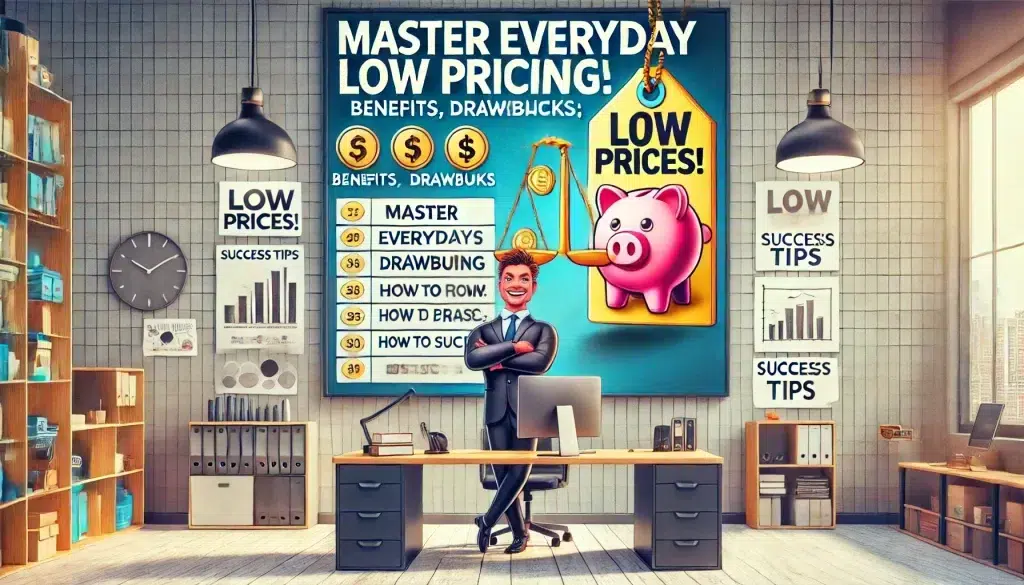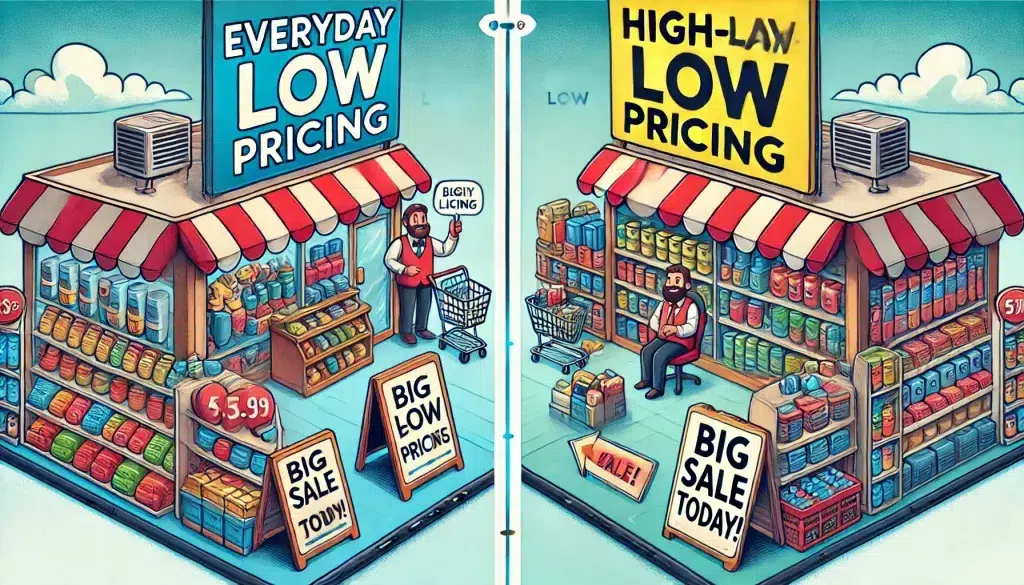
Discover the pros and cons of the everyday low pricing strategy and learn from brands like Walmart and Trader Joe’s that have mastered it. Make informed pricing decisions for your business.
Everyday low pricing (EDLP) is a crucial strategy for retailers, offering consistently low prices without frequent discounts. This approach attracts price-sensitive customers and builds trust. Walmart, using EDLP, reports over $500 billion in annual revenue. Aldi’s commitment to EDLP has driven its rapid global expansion.
A study by the National Retail Federation found that 60% of shoppers prefer stable, low prices over occasional sales. To maintain profitability, EDLP requires careful planning and operational efficiencies, such as optimizing supply chains. McKinsey & Company highlights these efficiencies as crucial.
Despite its benefits, EDLP has challenges, like managing slim margins and relying on high sales volumes. Deloitte reports that while effective EDLP can boost market share, poor execution can lead to financial strain. Balancing cost control and market alignment is essential for success. This strategy, when well-executed, fosters long-term customer loyalty and stable revenue growth.
Everyday Low Pricing vs. High-Low Pricing

Before adopting a pricing strategy, it’s crucial to distinguish between everyday low pricing and high-low pricing. High-low pricing involves initially setting high prices and later offering discounts or promotions. This approach can create a sense of urgency and excitement among consumers, encouraging them to purchase during sales periods.
Conversely, EDLP maintains stable, low prices, avoiding fluctuations in sales and promotions. This consistency can build customer trust and loyalty, as shoppers know they always get a fair deal without waiting for sales.
| Feature | Everyday Low Pricing (EDLP) | High-Low Pricing |
| Price Stability | Maintains stable, low prices | Initially high prices, with later discounts or promotions |
| Customer Perception | Builds trust and loyalty due to consistent pricing | Creates urgency and excitement during sales periods |
| Purchase Behavior | Shoppers know they are always getting a fair deal | Encourages purchases during sales, driven by discounts |
| Pricing Fluctuations | It avoids price fluctuations and frequent promotions | Involves regular price changes and promotional events |
| Marketing Focus | There is less need for constant advertising of sales | Requires frequent marketing to promote sales and discounts |
| Sales Strategy | Relies on stable pricing to attract regular customers | Uses discounts to drive short-term sales spikes |
| Customer Trust | Higher trust due to predictable pricing | Potentially lower trust if consumers feel manipulated by frequent price changes |
The Advantages of Everyday Low Pricing
Implementing an EDLP strategy offers several benefits that can enhance customer satisfaction and streamline business operations.
1. Simplified Decision-Making
With EDLP, customers don’t need to worry about missing out on sales or finding the best deal. This simplicity can increase customer loyalty and repeat business, as shoppers appreciate the consistent pricing. This means fewer complex pricing decisions and a more straightforward approach to setting prices for businesses.
2. Time Savings for Consumers
EDLP saves customers the hassle of comparing prices and hunting for deals. This convenience can significantly enhance the shopping experience, leading to higher satisfaction and more frequent purchases. Customers are more likely to return When they know they are always getting a good deal.
3. Improved Demand Forecasting
Consistent pricing helps businesses predict demand more accurately. Without the distortions caused by periodic sales, companies can analyze purchasing patterns and market conditions to forecast future demand better. This leads to more efficient inventory management and reduced risk of overstock or stockouts.
4. Reduced Marketing Costs
Maintaining everyday low prices can also lower marketing expenses. Companies with EDLP don’t need to promote sales and discounts, which can be costly constantly. For instance, Walmart’s EDLP strategy minimizes marketing efforts, saving substantial amounts on advertising campaigns.
The Drawbacks of Everyday Low Pricing
While EDLP offers many benefits, it also presents challenges that businesses must consider.
1. Potential Credibility Issues
In a highly competitive market, consumers can easily compare prices online. If they find competitors offering better deals, they may question your pricing strategy and switch brands. Maintaining competitive prices is crucial to retaining customer trust and avoiding losing credibility.
2. Lower Profit Margins
Offering consistently low prices can squeeze profit margins. Unlike high-low pricing, which can balance high initial prices with occasional discounts, EDLP requires always maintaining low prices. This can be significantly challenging if the cost of goods increases.
3. Challenges in Remaining Competitive
EDLP can sometimes create perceptions of lower quality. Consistently low prices might lead some consumers to believe that the products are inferior. This can be mitigated by emphasizing the quality and value of your offerings through marketing and customer education.
4. Critical Considerations for Implementing an EDLP Strategy
When deciding whether to implement an EDLP strategy, consider the following factors to ensure it aligns with your business goals.
5. Room for Growth
Analyze your market and product maturity. If your products are already well-known and have limited growth potential, EDLP might be a good fit. However, if your products require significant marketing to gain market share, you might need a different approach.
6. Purchasing Patterns
Consider the expandable purchasing patterns of your products. Items with high expandable consumption, like food products, might benefit from EDLP, as consumers buy them frequently. Products with less expandable consumption, like household goods, might not benefit as much from this strategy.
How to Choose the Right Pricing Strategy
Deciding between everyday low pricing (EDLP) and high-low pricing depends on your business goals, customer base, and operational capabilities. Each strategy has unique advantages and potential challenges, making it crucial to evaluate which aligns best with your Company’s objectives.
Consider Your Customer Base
Understand your target customer’s preferences and shopping behaviors. If your customers value consistency and reliability, EDLP may be more appealing. A National Retail Federation study found that 60% of shoppers prefer stable, low prices over sporadic sales, indicating that a significant portion of consumers favor predictability. On the other hand, if your customers enjoy hunting for deals and respond well to promotions, high-low pricing might better suit their needs.
Evaluate Your Operational Capabilities
Implementing EDLP requires streamlined operations and efficient supply chain management. Companies like Walmart and Aldi have successfully adopted EDLP by optimizing their logistics and reducing overhead costs, allowing them to maintain low prices consistently.
Using a tool like Pricefy can help your business achieve similar efficiencies by providing advanced price monitoring and dynamic repricing solutions, ensuring your pricing strategy remains competitive and profitable. Conversely, high-low pricing may be easier to implement if you have a robust marketing team and the ability to manage frequent promotional campaigns.
Assess Your Financial Goals
Consider your financial objectives and profit margins. EDLP can lead to steady sales and foster long-term customer loyalty but often involves lower profit margins per unit. This strategy relies on high sales volumes to be profitable. High-low pricing can generate higher profit margins during sales periods but may result in fluctuating revenue streams. Determine whether you prioritize stable, continuous revenue or can manage the peaks and troughs associated with high-low pricing.
Analyze Market Competition
Look at your competitors’ pricing strategies. If competitors predominantly use EDLP, adopting the same approach might help you stay competitive. However, if the market is saturated with high-low pricing, consistently low prices could differentiate your brand and attract loyal customers looking for reliable deals. Conversely, if most competitors use EDLP, you might stand out by implementing high-low pricing and creating excitement through regular promotions.
Consider Product Types
Your product types also influence the pricing strategy you choose. EDLP works well for everyday essentials and frequently purchased items, where customers appreciate knowing they are getting a good deal without needing to shop around. High-low pricing is often more effective for discretionary items or seasonal products, where consumers are more willing to wait for a sale.
By carefully evaluating these factors, you can choose the pricing strategy that best aligns with your business model, customer expectations, and financial goals. Whether you opt for EDLP or high-low pricing, the key is to implement your chosen strategy effectively and consistently to build customer trust and achieve long-term success.
Brands That Mastered Everyday Low Pricing
Several brands have successfully implemented EDLP, demonstrating its potential for enhancing customer loyalty and business performance.
IKEA
IKEA is a global home furnishings leader known for its everyday low-pricing strategy. By maintaining consistently low prices, IKEA attracts a broad customer base, offering stylish and functional furniture at affordable prices. The Company achieves this by optimizing its supply chain, using cost-effective materials, and encouraging customers to assemble their furniture, which helps reduce production and labor costs.
Aldi
The German discount supermarket chain Aldi employs EDLP to offer a no-frills shopping experience with consistently low prices. By simplifying its product range, focusing on private-label goods, and maintaining efficient store operations, Aldi can pass on savings to customers. This strategy has helped Aldi expand rapidly across Europe, the United States, and Australia, building a loyal customer base.
H&M
H&M, a leading fashion retailer, uses EDLP to provide trendy clothing at affordable prices. By maintaining tight control over its supply chain, producing in large volumes, and minimizing inventory costs, H&M ensures that customers always find fashionable items at low prices. This approach has made H&M a favorite among budget-conscious fashion enthusiasts.
Dollar General
Dollar General is a variety store chain in the United States that employs EDLP to attract cost-sensitive shoppers. By offering a wide range of everyday items, including groceries, household products, and apparel, at consistently low prices, Dollar General meets the needs of budget-conscious consumers. The Company’s focus on conveniently located small-format stores further enhances its appeal.
Conclusion
Everyday low pricing can be a powerful strategy for attracting and retaining customers, streamlining operations, and enhancing profitability. However, it requires careful planning and consideration of market conditions, consumer behavior, and competitive dynamics. By learning from successful brands and tailoring the strategy to your business needs, you can effectively implement EDLP to achieve long-term success.




